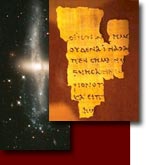| Site Map | Contacts | Links | Newsletter | |
Genesis 1
Conclusions
From this study I have learned that Genesis one is a polemic against the surrounding heathen nations, who worshipped many gods. It also seems to be etiological in nature, explaining the Sabbath as a day of rest.
Genesis one is not a scientific treatise on how the world was created. According to II Timothy 3:16 the Bible was meant for instruction in righteousness not science. God choose the simple framework of a week to explain the complex story of creation.
Genesis 1:1 - Summary Statement
Genesis 1:1 can be understood in two ways, either as a independent clause, being the summary statement of the chapter, or as a temporal clause meaning "when." What is for certain is that there is no ex nihilo creation in verse one. Creation starts in verse 3 with the command "Let there be light."
Genesis 1:2 - Pre-Creation State
Genesis 1:2 describes the pre-creation state of the world. The earth is described as a barren wasteland and devoid of life. A wind which is seen as the breath or Spirit of God blows over the watery deep.
Genesis 1:3-5 - Day One - Light
The picture described in Genesis 1:3-5 is the dawning of creation like the dawning of a new day. In the ANE and the Bible there is a difference between daylight and direct sun light. Daylight occurs an hour or two before the sun rises, and continues for an hour after sunset. In this pre-scientific age daylight was not the result of the sun.
Creation in the ancient world was not ex nihilo. It was one of separating and naming things. God commands and it is carried out just like the command of a king.
Genesis 1:6-8 - Day Two - The Firmament
The firmament was conceived as a solid vaulted structure that held up the heavenly ocean (Job 37:18). Gates or windows would open up to let rain out (Genesis 7:11, 8:2). There are pillars (mountains) that hold up heaven (Job 26:11). The heavens are said to be stretched out like a tent over the earth and the watery abyss (Isaiah 40:22, Job 26:7).
Genesis 1:9-13 - Day Three - Sea, land, and plants
All the waters under the firmament are collected together into one place. This seems to indicate there was one sea which surrounded one continent. Both the sea and the earth were considered circular, but not spherical (Job 26:10; Isaiah 40:22). The earth is stretched out over the deep and pillars hold it up (Job 26:7; Isaiah 42:5, 44:24; I Samuel 2:8). The earth is commanded to sprout forth vegetation.
Genesis 1:14-19 - Day Four - Sun, Moon, and Stars
This seems to be a polemic against the ANE view that the sun, moon, and stars were gods. In Genesis they are mere creations under Godís control. Planets were called "wandering stars" (Jude 13). Meteorites and sometimes comets were called "falling stars." The "morning star" was the planet Venus. Jesus is called the "bright and morning star" (Revelation 22:16). For just as Venus is three days and three nights below the horizon in the underworld then rises up, so too does Jesus.
Genesis 1:20-23 - Day Five - Birds, and Fish
On day five the fish and birds are created. In the ANE fish and birds where associated together because they are seen together near water and marshes. They may of thought that everything that lives in or near water, comes from water. Great flocks of birds are seen in and near water and marshes.
Genesis 1:24-31 - Day Six - Animals and Man
The earth is commanded to bring forth animals. This is not ex nihilo creation. The animals are to reproduce after their "kind" as the plants do. "Kind" should not be limited to "species."
There are three different ways "adam" is used in Genesis. "Adam" can just mean the generic term for mankind in general, or male in particular. In Genesis 1:27 the term "adam" includes both male and female referring to all humanity. In Genesis Two "adam" refers to a male in contrast to a female. Finally there is the historical person named "Adam." The historical Adam may be the same man named "Allum" the first king in the Sumerian King List who lived before the great flood. He was the first king of Eridu which may be Biblical Eden. In the ANE kings were considered to be the "image of god" even the very "son of god." It seems the Hebrews have democratized the "image of God" to refer to all mankind, and not just to the king rule over creation. Every plant and tree is given to man for food. There seems to be an ancient tradition that man and animals were herbivorous.
Genesis 2:1-4a - Day Seven - The Sabbath
The origin of the Sabbath is probably from the 6&7 day cycle of the phases of the moon each month. Probably during the captivity there was no one to watch for the phrases on the moon so it became disconnected from the lunar cycle. Later the sun, moon, and the planets were connected to the week which we still have today. Only the new moon and the full moon are mentioned in the OT.
Next - Appendix - Textual
Criticism
Bibliography
